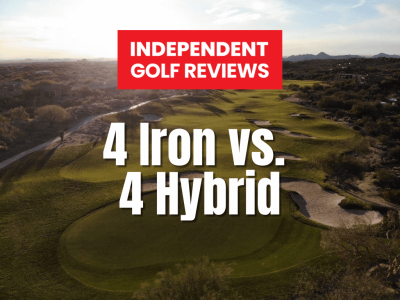- Updated: January 2, 2023
4 Iron vs. 4 Hybrid
Current generations of golfers are blessed with many alternatives to longer irons.
Long irons like a 4 iron require more swing speed and greater club face precision to hit accurately than hybrid golf clubs.
Hybrids (also referred to as a “Rescue Club”) were once thought to be designed only for beginners and amateurs struggling to hit longer approach shots but are now a popular long iron substitute for both amateurs and PGA Tour level professional players alike.
Unfortunately, the question of which is better between a 4 iron and 4 hybrid isn’t as simple as a “one size fits all” answer.

In our guide today, we’ll be answering that question by discussing the key differences between a 4 hybrid and 4 iron, the best examples of when and where to use each club, and some factors that can help your decision if you find yourself on the fence between the two club categories.
Why Do Players Need a 4 Iron or 4 Hybrid?
The primary goal of golfer’s long irons or hybrids is to create reliable and consistent longer distances to help players hit more greens-in-regulation (whether that be long Par 3’s or approach shots into Par 5’s) or tight fairways.
Unfortunately, many recreational and amateur players don’t generate enough ball speed or have enough club face control to hit a 4 iron consistently and accurately.
On the other hand, hybrids are designed to be forgiving and easier to strike solidly than a 4 iron. Slower swing speeds find a naturally higher and straighter ball flight with hybrids, but higher swing speed players will sacrifice spin and height control using a hybrid over a 4 iron.
4 Iron Explained:
A 4 iron usually has a loft angle between 21 and 24 degrees (with more game improvement style 4 irons nearing 19 degrees) and always has a much smaller sole and head shape than a hybrid, resulting in less natural forgiveness to users.
While we’ve already explained 4 irons are generally perceived as more challenging to hit than their hybrid counterparts, there are many cases for a 4 iron working just as well, if not better, for some player’s golf game.
Four irons have a lower peak apex, a more shallow descent angle from that peak apex, and less spin during the ball’s total flight from strike to finish. This makes 4 iron strikes lower in overall flight, greater in their roll out once they hit the fairway, and usually more challenging to hold greens from longer distances than hybrids unless you generate a lot of speed to create enough spin and are very consistent and accurate with your ball striking.
With 4 irons less forgiving and smaller head shape, shaping shots into a draw or fade flight pattern is much harder to accomplish than with a hybrid. That being said, controlling the height of a 4 iron (if you’re a good ball striker) and “flighting the ball” under or into the wind is much easier to accomplish with a 4 iron than a hybrid.
With a smaller head and sole comes less forgiveness from the rough and tricky lies. This makes the 4 iron a fantastic tool off tee boxes and out of fairway lies but not as versatile as a 4 hybrid in sticky situations and deeper rough.
4 Hybrid Explained:
As we’ve already discussed, a 4 Hybrid is generally perceived as the easier-to-hit club when compared to a 4 iron, but don’t confuse a hybrid as a long approach option only for poor contact and slow swing speed players.
Hybrid golf clubs naturally have a longer shaft length and larger head shape than 4 irons. This allows players to consistently swing the hybrid slightly faster, resulting in a little more speed and distance in direct comparison, even if the lofts are the same.
Additionally, hybrids are designed with more naturally forgiving faces so that the ball will come off faster from center hits on a hybrid than on a 4 iron.
As you might notice from the photo below, a hybrid club’s center of gravity is lower and deeper behind the golf ball than a 4 iron at address. This lower center of gravity gives hybrids their naturally higher and straighter ball flight, but it also makes their height difficult to control to the same degree as a 4 iron.
The larger sole, head shape, and emphasized leading edge of the hybrids club face makes them much more versatile out of poor lies and deeper rough. Their wider soles create the exceptional turf interaction players feel compared to the small sole iron. A hybrid will “dig” the ball out of deeper lies, whereas a 4 iron will have trouble in the same situation.
The initial launch angle with a 4 hybrid is much more severe than a 4 iron. Since the ball launches higher faster with a hybrid, getting over immediate danger quickly, like steep fairway bunker lips, is easier accomplished with one than a long iron alternative.
Hybrids have a higher peak apex, a more steep descent angle from that peak apex, and more spin during the ball’s overall flight, making hybrid strikes higher in height, shorter in rollout, and easier to hold greens from longer distances than 4 irons for the average player inconsistent with their ball striking.
Different Best Uses of 4 Iron vs. 4 Hybrid
Hopefully, you now have a good understanding of the differences in design and ease of use between the 4 hybrid vs. 4 iron.
At this point, we’d like to explain each club’s best situations and uses to better help players on the fence between the two.
As always, we encourage our readers to test any equipment for themselves before purchasing, but if this isn’t a feasible option for you, our breakdown should certainly help.
4 Iron Best Uses
The feeling of a well struck 4 iron is difficult to fully explain, but we’re sure it’s made many golfers return to the game.
Players confident in their iron striking ability would rather have the potential to flight balls low for additional run out with 4 irons than sacrifice that ability for easier, straight, high-flying shots with a hybrid.
To answer the question of which is better in even more detail, Trottie from TaylorMade tested a long iron vs. a 4 hybrid and found some fascinating results.
Players that generate more than average swing speed but attack the ball from a steeper angle (like Trottie) have more success with a 4 iron than a 4 hybrid. Having adequate swing speed and higher spin from a steeper attack angle results in greater consistency in a 4 iron since a steeper attack angle on a hybrid that already generates exponentially more spin than an iron causes unpredictability in flight pattern.
The lower initial launch angle from a 4 iron makes it a much better option to get under trouble than a hybrid.
Additionally, having a more piercing ball flight makes a 4 iron a better option in high wind areas or links-style golf courses. Players looking to run the ball to their intended target or just hit lower shots that hit the fairway and start running can accomplish that with 4 irons, whereas hybrids don’t really offer that type of versatility.
Wind won’t affect the lower apex 4 iron shots as much, and players will have more distance in the wind from the increased rollout.
4 Hybrid Best Uses
While extremely satisfying in their own right, hybrid shots don’t require the same level of ball-striking skill to complete as long iron alternatives.
Players that are slightly less confident in their ball-striking ability see more confidence and better results from the easier-to-hit and much larger hybrids.
A fantastic area to use a hybrid is at golf courses requiring longer approach shots into greens that are guarded by hazards like bunkers or water. Players unconfident in their iron striking skills or looking to ensure they cover the danger have a better time with the high-flying and quickly stopping hybrids.
Additionally, low spin players that have more of a sweeping motion towards the ball at contact benefit strongly from the naturally higher spin hybrid clubs generate. This results in more height, distance, and playability for low swing speed and low spin players.
A naturally higher spin rate means more wind influence, so if the area you play golf most frequently is very windy, you should factor that into your club buying decision process.
Ball Position and Technique for 4 Hybrid vs. 4 Iron
The technique for both a 4 Hybrid and 4 Iron are in all essences the same.
Since both the clubs have similar lofts, maximum distance, and carry distance, their setup at address can be thought of in the same category.
Players can start by positioning the golf ball one club head length inside their leading heel. This positions the ball forward (towards the target) of the player’s center to allow the golf club, whether it be a hybrid or long iron, to bottom out at the correct area for its length.
To see the best results, a player should distribute their weight evenly (50/50) between their two feet or ever so slightly favoring their lead side (60/40) to help eliminate fat shots caused by trying to help the ball flight higher in the air.
Most golfers who struggle to hit long irons and hybrids consistently are often swinging faster than they usually would. This might come from both clubs having some of the longest shafts of any club in a player’s golf bag, which naturally generates more club head speed.
More club head speed can result in an unbalanced swing and off-center strikes. Try to swing smoothly and hold your follow-through to ensure proper balance. This should lead to more consistent results.
Final Thoughts with @scramblingtom
It’s pretty clear there are significant instances to use either a 4 iron or a 4 hybrid, but calling one explicitly better than the other doesn’t make much sense.
The beginner, weekend, or average golfer that struggles to find the center of the club face and has moderate to slower swing speed should likely have at least one hybrid in the bag. On the flip side, high swing speed players confident in their skill and ball-striking ability will fair just as well with a longer iron.
We also discussed how the golf course a player frequents could determine which club will be a better option.
Players with trouble hitting in windy conditions or looking to have increased roll on more fairways should likely consider the lower spinning and flying 4 iron. On the other hand, golfers needing to carry danger or those who always want longer shots to land softly will have much more success with a hybrid than a long iron.
Use this knowledge to make your club buying question a little more personal.
While you’re here, check out our Best Hybrids Buyer’s Guide to see where we rank the top hybrids on the market, so you know where to start testing!
About The Author
Writers of Independent Golf Reviews
Independent Golf Reviews has tested and reviewed 1000+ golf products over the past 10 years. We use our experience and expertise to give golfers an unbiased insight on the market.
Read more…
Share
Receive the best golf discounts available exclusively for our subscribers and be auto entered into our monthly golf giveaways!
Success!⛳️
You are now an official member of IGR. Keep an eye out for the perks.
No spam, ever. 🔒

